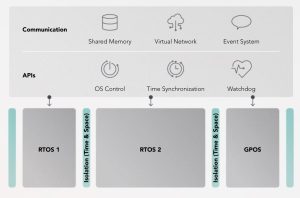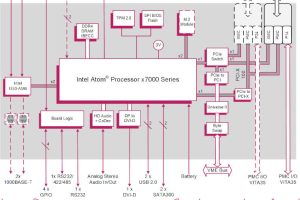
The hypervisor in question is related to RTS Hypervisor from Real-Time Systems – a company owned by Congatec, and installed as part of the BIOS.
“It uses the same technology as RTS Hypervisor, but it is integrated in the modules” the company told Electronics Weekly, explaining: “It is not stand-alone software [like] RTS Hypervisor. [It is a bare-metal hypervisor – a hypervisor type 1 – it runs directly on the hardware and does not need a host operating system, unlike type 2 hypervisors like VMware.”
Hypervisors, sometimes working with specific hardware on the processor IC, allow different blocks of code (such as operating systems) to to share the same hardware without any interaction between the blocks of code.
 This strict separation increases security and reliability, as the hypervisor prevents hacking from one block to another, and prevents others failing if one code block crashes.
This strict separation increases security and reliability, as the hypervisor prevents hacking from one block to another, and prevents others failing if one code block crashes.
They work by carefully time-sharing and partitioning resources, including multiple cores and memory, between the running programmes.
In the Congatec case, “every OS is assigned to run on its own core or set of cores and I/Os, such as PCIe, Ethernet or USB, so that each OS can run entirely independently from each other”, it said. “Booting or suspending the operation of any OS will have no effect on any other. With the hypervisor, customers get a software and hardware package already qualified to support real-time applications, as the real-time behavior of the modules has already been verified.”
The Congatec hypervisor has nested virtualisation with container and virtual machine (VM) support.
Nested virtualisation runs a VM on top of another hypervisor, rather than on physical hardware. “Individual workloads can be decoupled from each other to increase reliability, for example, or containers, or other virtualisation solutions, could be run within a VM,” the company said.
It can currently host: Windows 10, Windows 11, Debian, Ubuntu, VxWorks, Xenomai, TenAsys Intime distributed RTOS, QNX Neutrino and Real-Time Linux.
“Support for other operating systems can be added anytime upon request,” said Congatec. “Different operating systems may run in different execution modes at the same time, and any mix of symmetric multiprocessing and single-CPU, 32bit and 64bit is possible.”
While the installed firmware does not affect the cost of buying the module, a licence fee is due if purchasers use the hypervisor.
“It can be used for a limited trial time for no cost,” the company said. “Only if the customer wants to use it for his applications, then cost will incur for the licence. If you don’t use it, you don’t have to pay for it.” – the mechanism is a form of expiry date in the firmware, after which hypervisor reactivation is required.
A list of Congatec’s hypervisor-inclusive computer-on-modules can be found here.
 Electronics Weekly Electronics Design & Components Tech News
Electronics Weekly Electronics Design & Components Tech News



